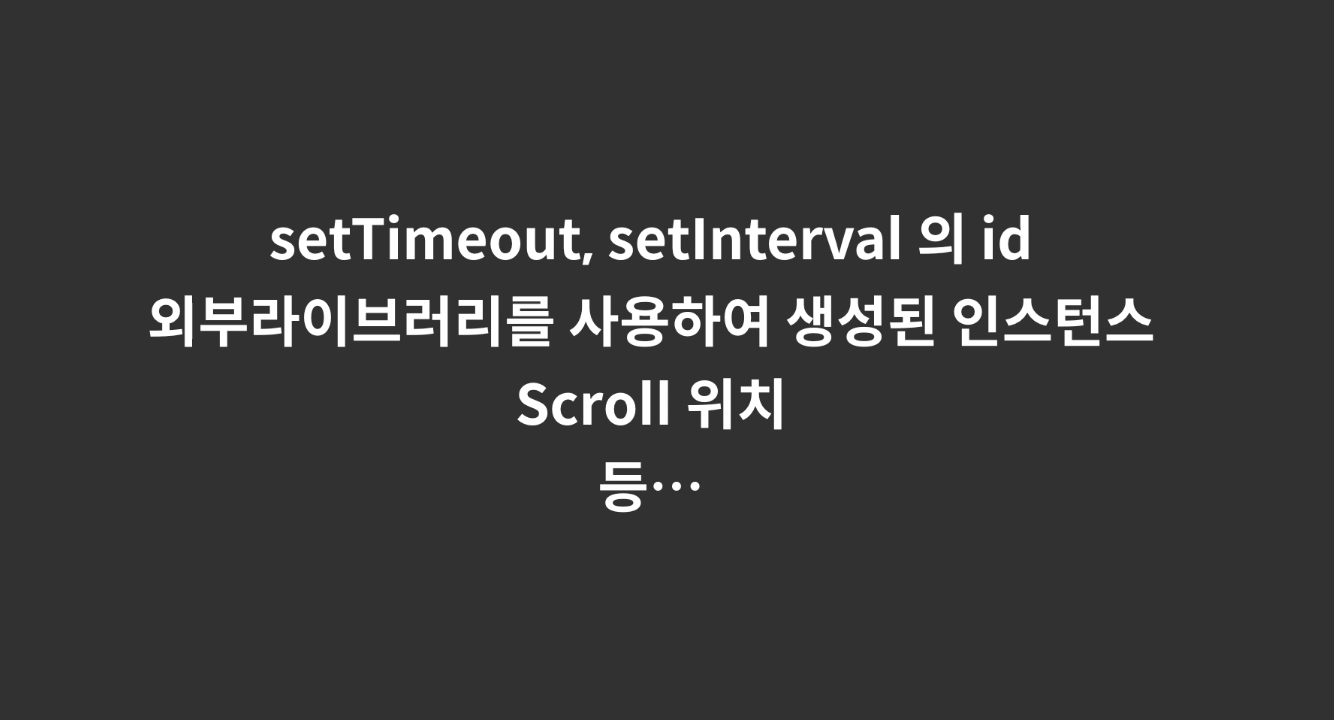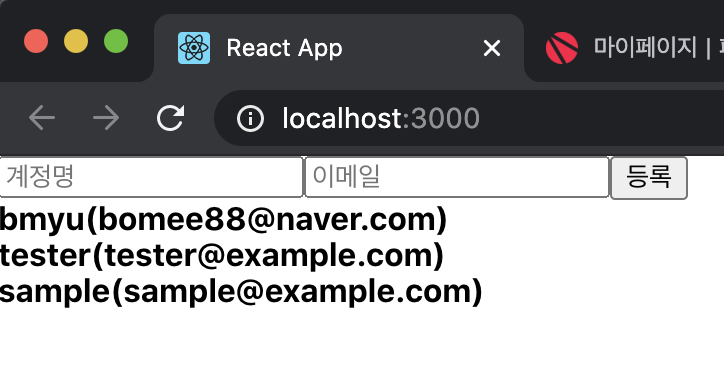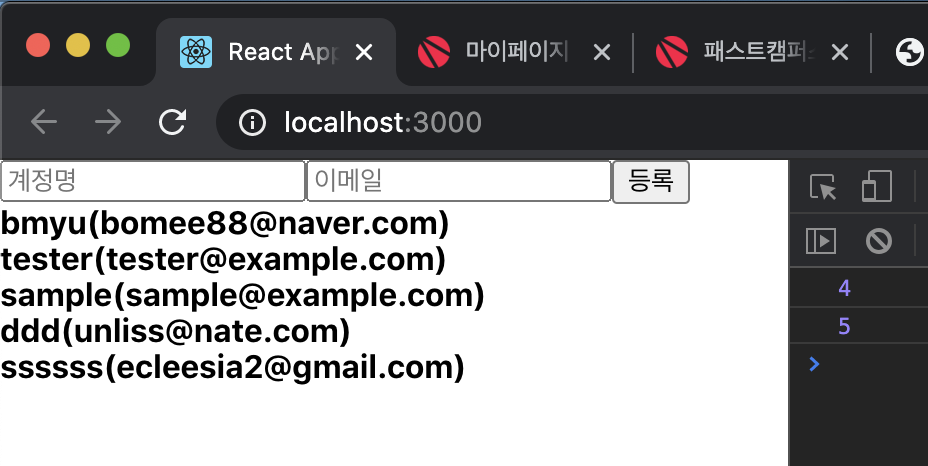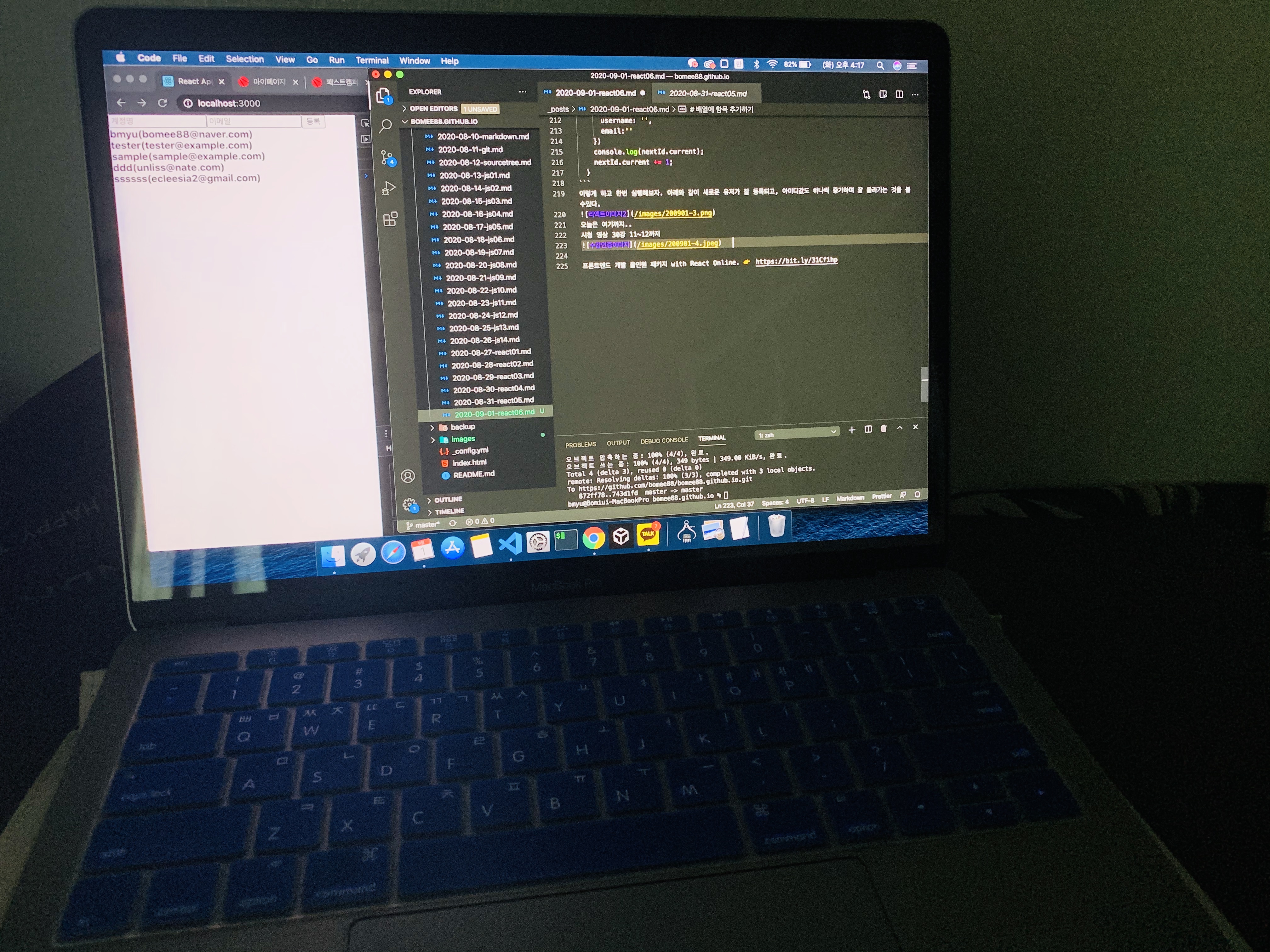[패스트캠퍼스 수강 후기] 프론트엔드 인강 100% 환급 챌린지 23회차 미션 - 30강 React useRef로 컴포넌트 안의 변수 만들기, 배열에 항목 추가하기
useRef로 컴포넌트 안의 변수 만들기
컴포넌트가 리랜더링 될때마다 계속 기억해야하는 어떠한 값을 관리할때도 사용할 수 있다.
주로 아래와 같은 상황들이 기억해야하는 상황이다.

useRef로 관리 하는 값은 컴포넌트가 리랜더링 되더라도 값이 바뀌지 않는다는 것을 알아두어야 한다.
자 먼저 이전시간에 만들었던 UserList.js를 조금 수정해보자.
UserList.js
import React from 'react';
function User({ user }){
return(
<div>
<b>{user.username}<span>({user.email})</span></b>
</div>
)
}
function UserList({ users }){
return(
<div>
{
users.map(
user => (<User user={user} key={user.id}/>) //각 객체마다 가지고 있는 고유값을 설정해주어야 함. key
)
}
</div>
)
}
export default UserList;
위와 같이 바꿔준다. 기존에 있었던 배열 users를 잘라내서 App.js로 옮겨 붙이고 UserList 함수 안에서는 파라미터 값으로 users를 받아오게 설정해준다.
App.js
import React, { useRef } from 'react';
import UserList from './UserList';
function App() {
const users = [
{
id: 1,
username: 'bmyu',
email: 'bomee88@naver.com'
},
{
id: 2,
username: 'tester',
email: 'tester@example.com'
},
{
id: 3,
username: 'sample',
email: 'sample@example.com'
}
];
const nextId = useRef(4);
const onCreate = () => {
console.log(nextId.current); // 4
nextId.current += 1;
}
return(
<UserList users={users}/>
)
}
export default App;
위와 같이 App.js에 users를 붙여넣고 return에서 UserList 컴포넌트에 users={users}로 보내준다. 저장하고 새로고침 해보면 기존 그대로 잘 나온다. 그 다음 nextId를 추가하고 onCreate라는 함수를 하나 더 만들어준다. 여기서 우리가 기억해야 할 것은 useRef를 DOM에서 ref로 불러서 쓰는 것 말고도 이런식으로 변수를 기억하고 싶을때도 쓴다. 또 useRef로 관리해준 이유는 nextId가 바뀐다고 해서 컴포넌트가 리랜더링이 될 필요가 없기 때문이다. 아무튼 이러한 용도로도 useRef를 쓴다는 걸 알아두고 넘어가자.
배열에 항목 추가하기
배열에 항목을 추가하는 퍼포먼스를 만들기 위해서 아래와 같이 코드를 추가해보자.
먼저 CreateUser.js를 하나 더 만든다.
CreateUser.js
import React from 'react';
function CreateUser({ username, email, onChange, onCreate }){
return(
<div>
<input
name="username"
placeholder="계정명"
onChange={onChange}
value={username}
/>
<input
name="email"
placeholder="이메일"
onChange={onChange}
value={email}
/>
<button onClick={onCreate}>등록</button>
</div>
);
}
export default CreateUser;
그리고 App.js에 CreateUser 컴포넌트를 등록시켜주고 useState를 활용해 아래와 같이 수정해보도록 하자.
App.js
import React, { useRef, useState } from 'react';
import UserList from './UserList';
import CreateUser from './CreateUser';
function App() {
const [inputs, setInputs] = useState({
username: '',
email: '',
})
const { username, email } = inputs;
const onChange = e =>{
const { name, value } = e.target;
setInputs({
...inputs,
[name]: value
});
}
const [users, setUsers] = useState([
{
id: 1,
username: 'bmyu',
email: 'bomee88@naver.com'
},
{
id: 2,
username: 'tester',
email: 'tester@example.com'
},
{
id: 3,
username: 'sample',
email: 'sample@example.com'
}
]);
const nextId = useRef(4);
const onCreate = () => {
setInputs({
username: '',
email:''
})
console.log(nextId.current); // 4
nextId.current += 1;
}
return(
<>
<CreateUser
username={username}
email={email}
onChange={onChange}
onCreate={onCreate}
/>
<UserList users={users}/>
</>
)
}
export default App;
이렇게까지 수정하고 나면 아래와 같은 화면으로 보여질 것이다.

그러나 아직 인풋창에 써넣고 등록을 눌러도 추가되진 않는다. 이제 배열에 새로운 유저를 등록할 수 있는 코드를 만들어보도록 하자. 참고로 push, splice, sort같은 함수는 사용해주면 안된다. 기존의 배열을 한번 복사해놓고 사용해야 기존 배열의 불변성을 지킬 수 있기때문에 스프레드 연산자를 활용하여 올바른 방법으로 항목을 추가해보자.
App.js에서 onCreate부분만 바꿔보자
const onCreate = () => {
const user = {
id: nextId.current,
username,
email,
};
setUsers([...users, user]); // 스프레드 연산자 활용
setInputs({
username: '',
email:''
})
console.log(nextId.current);
nextId.current += 1;
}
user의 값을 받아와서 스프레드 연산자를 활용하여 setUser로 보내고 setInput을 초기화한다.
지금은 …인 스프레드 연산자를 활용했지만 concat 함수를 사용할수도 있다.
const onCreate = () => {
const user = {
id: nextId.current,
username,
email,
};
setUsers(users.concat(user)); //concat 함수 활용
setInputs({
username: '',
email:''
})
console.log(nextId.current);
nextId.current += 1;
}
이렇게 하고 한번 실행해보자. 아래와 같이 새로운 유저가 잘 등록되고, 아이디값도 하나씩 증가하며 잘 올라가는 것을 볼 수있다.

오늘은 여기까지..
시청 영상 30강 13~14까지

프론트엔드 개발 올인원 패키지 with React Online. 👉 https://bit.ly/31Cf1hp

Comments